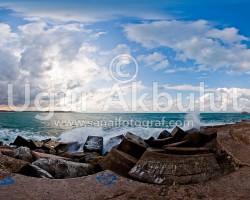[pano file=”http://www.sanalfotograf.com/ugurakbulut/amasra-dalgakiran-grafiti-1.swf” width=”100%” height=”556″]
| Amasra, Batı Karadeniz Bölgesinde, Bartın iline bağlı bir ilçedir. Son yıllarda turizm potansiyelindeki artışla dikkat çekmektedir.
Denize doğru uzanmış bir burun, burnun iki yanında korunaklı birer liman görevi gören iki koy ve ana karaya bağlı ve bağımsız adaları ile eşsiz bir görsel güzelliğe de sahip olan Amasra hem 3000 yıllık tarihi, hem çekicilik ve balıkçılığa dayanan yerel sanatları, hem de kendini çevreleyen ormanlık alanları ile görülmeye değer yerlerden biridir. Amasra halen özgün balık lokantaları, temiz orta boyuttaki otelleri ve sayısız ev pansiyonuyla turizme katkıda bulunmaktadır.Sanatçı Barış Akarsu’nun memleketidir. Barış Akarsu Ocak 2007 ‘da çıkardığı son kasetini Amasralılara ithaf etmiştir. 13. Yüzyılda Cenevizliler tarafından ele geçirilen Amasra’ya Fatih Sultan Mehmet 1460 yılı Ekim ayında bir sefer düzenler. Şehre hakim bir tepeye geldiğinde hayranlığını belli eden meşhur sözü eder: “Lala, lala!, çeşm-i cihan bu m’ola” ve kaleye haber gönderir: “Bu kadar güzel bir yere zarar vererek almak istemem kalenin anahtarını bana getiriniz.” Bunun üzerine kale komutanı anahtarı Fatih’in bulunduğu tepeye getirir ve şehir savaşmadan zapdedilmiş olur. İlçenin nüfusu 2000 genel nüfus sayımına göre 16122’dir. Bunun 6338’si ilçe merkezinde, 9784’i ise kasaba ve köylerde yaşamaktadır. “Amasra, Bartın.” Wikipedia, Özgür Ansiklopedi. 10 Eyl 2009, 02:48 UTC. 5 Ekim 2009, 10:25 <http://tr.wikipedia.org/w/index.php?title=Amasra,_Bart%C4%B1n&oldid=6364547>. ———————————————————————————————————————————————————————— ENGLISH Amasra (pop. 7000; from Greek Amastris Ἄμαστρις, gen. Ἀμάστριδος) is a small Black Sea port town in the Bartın Province, Turkey. The town is today much appreciated for its beaches and natural setting, which has made tourism the most important activity for its inhabitants. Amasra has two islands: the bigger one is called Büyük ada (Great Island) while the smaller one is called Tavsan adası (Rabbit Island). History The territory of Amastris produced a great quantity of boxwood, which grew on Mount Cytorus. Its tyrant Eumenes presented the city of Amastris to Ariobarzanes of Pontus in c. 265–260 BC rather than submit it to domination by Heraclea, and it remained in the Pontic kingdom until its capture by Lucius Lucullus in 70 BC in the second Mithridatic War.[9] The younger Pliny, when he was governor of Bithynia and Pontus, describes Amastris, in a letter to Trajan,[10] as a handsome city, with a very long open place (platea), on one side of which extended what was called a river, but in fact was a filthy, pestilent, open drain. Pliny obtained the emperor’s permission to cover over this sewer. On a coin of the time of Trajan, Amastris has the title Metropolis. It continued to be a town of some note to the seventh century of our era. The city was not abandoned in Byzantine Era, when the acropolis was transformed into a fortress and the still surviving church was built. It was sacked by the Rus during the First Russo-Byzantine War in the 830s. But it was in 1261 that Amastris regained part of its former importance; in that year the town was taken by the Italian city-state of Genoa in its bid to obtain sole control of the Black Sea trade. Genoese domination ended in 1460 when the Ottoman Sultan Mehmed II conquered the whole Anatolian shores of the Black Sea, forcing its inhabitants to move to Istanbul. The Greeks were replaced with Turkish villagers and the church became a mosque, the town losing most of its former importance. Features Wikipedia contributors. “Amasra.” Wikipedia, The Free Encyclopedia. Wikipedia, The Free Encyclopedia, 2 Jul. 2010. Web. 7 Jul. 2010. |
|



Henüz yorum yapılmamış